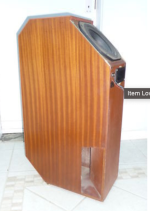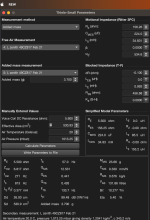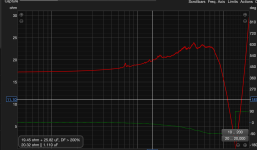@DrBoar. I am in the first stages of taking a stab at building a decca corner horn, starting with the West plans, but then trying to adjust to use a zenith driver I rescued from an old cabinet (Fs ~57 Hz, 26mm). My thinking was to tweak using driver parameters and "optimize" a bit. But my real question/ challenge is how to blend in a tweeter to the system. Attached is the response curve of the driver.
My plan is to utilize this in a single speaker, mono mode, but I need some help in the higher frequencies.
I saw that the Lowther corner Accousta had ?a version? with the tweeters mounted below the woofer, vertically on the face, also facing back towards the corner?
attached is also a shot of the accousta i am describing.
I had been thinking about a front facing horn/waveguide, but this would seem to be a lot simpler? Again, this is for mono.
Would love peoples thoughts on this method of aiming the tweeter?
My plan is to utilize this in a single speaker, mono mode, but I need some help in the higher frequencies.
I saw that the Lowther corner Accousta had ?a version? with the tweeters mounted below the woofer, vertically on the face, also facing back towards the corner?
attached is also a shot of the accousta i am describing.
I had been thinking about a front facing horn/waveguide, but this would seem to be a lot simpler? Again, this is for mono.
Would love peoples thoughts on this method of aiming the tweeter?
Attachments
That is an obvious "hacklowther". The Enclosure looks original Lowther but the drive units is something else. Both Lowther and Philips 9710 rise by about 10 dB above 2 kHz. The total energy output is less dramatic as directivity is quite high due to the cone (compared to a dome or other tweeter)
Do you have any info about the Zenit driver other than Fr?
I can not speak for the Lowther Corner Accousta but the Decca was quite tolerant. Normal 8" drivers with Fr 35-45 Hz Q 0.35-0.50 was the best but light coned high Q drivers like Philips and Axiette with Q of 0.7 to 1.0 and Fr in the 50-65 Hz range allso worked well. As long as you stay away from drivers with both high Q and low Fr you should be OK.
Why not mount the tweeter on a small temporary baffle on top of the cabinet and try both with it facing forward and backwards! What ever floats your boat is the way to go.
Do you have any info about the Zenit driver other than Fr?
I can not speak for the Lowther Corner Accousta but the Decca was quite tolerant. Normal 8" drivers with Fr 35-45 Hz Q 0.35-0.50 was the best but light coned high Q drivers like Philips and Axiette with Q of 0.7 to 1.0 and Fr in the 50-65 Hz range allso worked well. As long as you stay away from drivers with both high Q and low Fr you should be OK.
Why not mount the tweeter on a small temporary baffle on top of the cabinet and try both with it facing forward and backwards! What ever floats your boat is the way to go.
Zenith driver - here are the REW generated T/S params, by added mass method. done by me, so open to suggestions (e.g., should I use more mass?).
up until now, i have been using spicytl, looking at things from a transmission line perspective. But, being a complete novice, I think I was completely ignoring/misunderstanding the impedance side of things...i was only looking at resonance and wall abosrption. I am sure I still don't understand half of what I need to, but stealing my son's old windows laptop and installing Hornresp opened my eyes. Particularly the ability to quickly visualize the impedance within the various stages of the line/horn.
I am still in the process of learning Hornresp in the detail needed to really model accurately, but at least I am starting to get a feeling (famous last words).
To your point re the flexibility of the Decca to a wide range of drivers. Is this because the very large cross sectional area isn't really providing a lot of targeted impedance, whereas something like the Brociner seems to use impedance to control the driver to a much greater extent.
So the impedance interactions of the decca corner horn would be mainly caused by resonant modes, whereas the brociner is also using the air impedance as well? Am I right here?
I think this can be answered with a little more digging into Hornresp. FWIW - it takes a LOT ton get me onto a windows platform, and Hornresp is worth the battle.
FWIW - for "tweeter" my plan is to also reutilize the midrange which came out of the same 1960s system - which will only get me to about 5-6Khz or so. So I still need a real tweeter solution. What I am calling a midrange is a 7" driver with a cone lacking any flexibility where it is bonded to the cage (so only moving in the throat area). This would put an upper crossover at 5-6K...bad idea? Recommendation? I like the thought (look) of a wooden waveguide solution...but something I can DIY w/o a lathe or cnc...
up until now, i have been using spicytl, looking at things from a transmission line perspective. But, being a complete novice, I think I was completely ignoring/misunderstanding the impedance side of things...i was only looking at resonance and wall abosrption. I am sure I still don't understand half of what I need to, but stealing my son's old windows laptop and installing Hornresp opened my eyes. Particularly the ability to quickly visualize the impedance within the various stages of the line/horn.
I am still in the process of learning Hornresp in the detail needed to really model accurately, but at least I am starting to get a feeling (famous last words).
To your point re the flexibility of the Decca to a wide range of drivers. Is this because the very large cross sectional area isn't really providing a lot of targeted impedance, whereas something like the Brociner seems to use impedance to control the driver to a much greater extent.
So the impedance interactions of the decca corner horn would be mainly caused by resonant modes, whereas the brociner is also using the air impedance as well? Am I right here?
I think this can be answered with a little more digging into Hornresp. FWIW - it takes a LOT ton get me onto a windows platform, and Hornresp is worth the battle.
FWIW - for "tweeter" my plan is to also reutilize the midrange which came out of the same 1960s system - which will only get me to about 5-6Khz or so. So I still need a real tweeter solution. What I am calling a midrange is a 7" driver with a cone lacking any flexibility where it is bonded to the cage (so only moving in the throat area). This would put an upper crossover at 5-6K...bad idea? Recommendation? I like the thought (look) of a wooden waveguide solution...but something I can DIY w/o a lathe or cnc...
Attachments
My main experience with Lowthers is PM6C in the original Acousta horn which I think is the Acousta116 today (855x468x373) Early 70s
IMnotsoHO, these were some of very few speakers from that era which would stand up well against 'modern' speakers in a DBLT. No, they wouldn't beat a Spendor BC1 in midrange clarity, but not many, even today, could do this.
They were certainly MUCH better than the Tannoy DCs of that time which were still being used by the BBC as 'monitors'. The poor audible performance of the Tannoys was one of the reasons the BBC started designing their own stuff.
Looking at the TS of present Lowthers, including PM6C, it is obvious they won't do well in bass reflex unless you don't want stuff much below 100Hz or use EQ like the MiniOnkens.
I did once cobble the PM6Cs from the Acoustas into a pair of Paralines, a mass loaded folded tapered QW line. This had fairly flat & powerful LF response down to at least 40Hz, better than the Acoustas, but also other problems which led me to prefer the Acoustas for the PM6Cs. My facilities for measuring response were primitive in dem days.
So my question for Dave & Scott. "Have you got a box design that allows a single PM6C to perform well down to 40Hz without EQ?" ie using more box volume for better LF. The Paraline sorta did that with some lumpiness above 100Hz.
BTW, Neodynium is about the worst magnet material you can use for speakers and Alnico is probably the best you can get.
And the 'new' phase plugs are a joke ... but probably pontificating from da wrong orifice as I've never heard these offerings 😊
IMnotsoHO, these were some of very few speakers from that era which would stand up well against 'modern' speakers in a DBLT. No, they wouldn't beat a Spendor BC1 in midrange clarity, but not many, even today, could do this.
They were certainly MUCH better than the Tannoy DCs of that time which were still being used by the BBC as 'monitors'. The poor audible performance of the Tannoys was one of the reasons the BBC started designing their own stuff.
Looking at the TS of present Lowthers, including PM6C, it is obvious they won't do well in bass reflex unless you don't want stuff much below 100Hz or use EQ like the MiniOnkens.
I did once cobble the PM6Cs from the Acoustas into a pair of Paralines, a mass loaded folded tapered QW line. This had fairly flat & powerful LF response down to at least 40Hz, better than the Acoustas, but also other problems which led me to prefer the Acoustas for the PM6Cs. My facilities for measuring response were primitive in dem days.
So my question for Dave & Scott. "Have you got a box design that allows a single PM6C to perform well down to 40Hz without EQ?" ie using more box volume for better LF. The Paraline sorta did that with some lumpiness above 100Hz.
BTW, Neodynium is about the worst magnet material you can use for speakers and Alnico is probably the best you can get.
And the 'new' phase plugs are a joke ... but probably pontificating from da wrong orifice as I've never heard these offerings 😊
In 1976 we built the same Acousta with PM6A. We were rookie builders, used K3 particle board, drove them with an SCA-80/PAT-4 combo. Didn’t sound very good. Tool a while to realize that it was that pair of Dynacos that were thge problem.
I thot much the same until a client asked me to look at PM6A. Why i did i was surprised. Ended up with these. Versions for 3 different PM6 have been made. People seem quite happy.

dave
TS of present Lowthers, including PM6C, it is obvious they won't do well in bass reflex
I thot much the same until a client asked me to look at PM6A. Why i did i was surprised. Ended up with these. Versions for 3 different PM6 have been made. People seem quite happy.
dave
I still have those plans you created for me in my "to do" file. It's not a simple build....I thot much the same until a client asked me to look at PM6A. Why i did i was surprised. Ended up with these. Versions for 3 different PM6 have been made. People seem quite happy.
Dave, do you recommend electronic EQ for these MiniOnkens with PM6C ?I thot much the same until a client asked me to look at PM6A. Why i did i was surprised. Ended up with these. Versions for 3 different PM6 have been made. People seem quite happy.
ScottMoose, have you offerings for PM6 too?
I tried the Decca both facing forward and backward. With ordinary drivers either way could work. With Philips 9710 it sounded way better with the driver facing the backwall or corner due to elevated frequency response above 2 kHz.
http://www.troelsgravesen.dk/philips9710.htm
http://www.troelsgravesen.dk/philips9710.htm
Jeff
The T/S parameters as such look good. However, some things look a bit off.
The T/S parameters as such look good. However, some things look a bit off.
- Using a 3.7g weight at least DATS work better when the added weight is a larger fraction of moving mass?
- A surface ara of 530 cm2 denotes a 12" driver? Is it a 12 or 8 " driver? The surface area does not interact with Fr and Qt but with the value of Vas and thus any calulations of boxes.
Well, my math skills are clearly lacking... the driver is, in fact a 10" driver. I don't know who broke into my house and adjusted this parameter! I will redo with more mass as well... I have more thoughts/questions, but I feel that most are off the main topic.
thanks!
thanks!
- Home
- Loudspeakers
- Full Range
- Lowther cabinet plans



